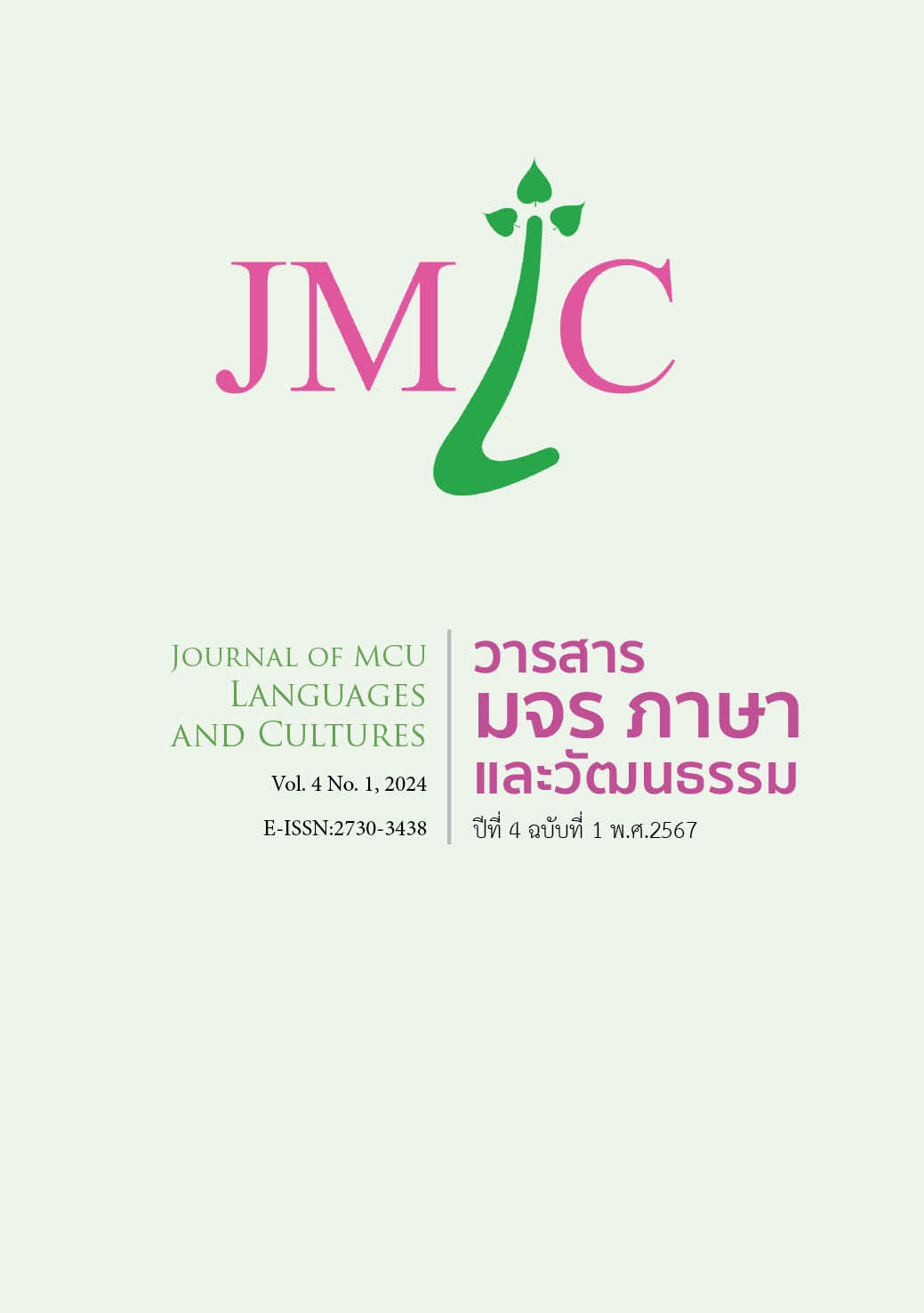การเสริมสร้างความสัมพันธ์ระหว่างครูและนักเรียนด้วยสังคหวัตถุ
คำสำคัญ:
ความสัมพันธ์ของครูและนักเรียน, แนวคิดในพุทธศาสนา, พระพุทธศาสนา, สังคหวัตถุบทคัดย่อ
บทความนี้มีวัตถุประสงค์เพื่อศึกษาความสัมพันธ์ระหว่างครูกับนักเรียน ผลกระทบเชิงลบและเชิงบวกของความสัมพันธ์ และคุณลักษณะของครูในการสร้างความสัมพันธ์เชิงบวกกับนักเรียน รวมทั้งสังคหวัตถุ 4 ประการในพระพุทธศาสนาเพื่อช่วยสร้างความสัมพันธ์ที่ดีของครูและนักเรียน ประกอบด้วย 1. การให้ เช่น ให้ความรู้หรือคำแนะนำ (ทาน) ช่วยสร้างความรู้สึกเชิงบวกและความเชื่อใจให้กับนักเรียน 2. ปิยวาจาช่วยเสริมสร้างการสื่อสารที่มีประสิทธิภาพทั้งวัจนและอวัจนภาษาซึ่งนำหลักการของวาจาสุภาษิตมาปรับใช้ ประกอบด้วยคำพูดที่เหมาะสมแก่กาล เป็นความจริง อ่อนหวาน เป็นประโยชน์ และกล่าวด้วยเมตตาและความปรารถนาดี 3. อัตถจริยาเป็นการประพฤติเพื่อมุ่งประโยชน์ 3 ประการคือ ประโยชน์ตน (อัตตัตถะ) ในที่นี้คือครู ประโยชน์ผู้อื่น (ปรัตถะ) - นักเรียน และ ประโยชน์ทั้งสองฝ่าย (อุภยัตถะ) - ครู นักเรียนและสังคม 4. การประพฤติตนเสมอต้นเสมอปลายและปฏิบัติต่อผู้อื่นอย่างเท่าเทียม (สมานัตตตา) ช่วยสร้างความมั่นใจของนักเรียนที่มีต่อครู ทำให้นักเรียนกล้าเปิดใจพูดคุยซึ่งจะช่วยสร้างความสัมพันธ์ที่ดีระหว่างครูและนักเรียนได้มากขึ้น
เอกสารอ้างอิง
Agyekum, S. (2019) Teacher-Student Relationships: The Impact on High School Students.
Journal of Education and Practice. 10 (14), 121-122.
Bai, L. Y. et al. (2022). Student–Teacher Relationship: Its Measurement and Effect on Students’
Trait, Performance, and Wellbeing in Private College. Educational Psychology. 13. https://doi.org/10.3389/fpsyg.2022.793483.
Bhikkhu Sujato tr. (2018). Dutiyahatthakasutta. (AN 8.24). Retrieved April 10, 2024, from
Brinkworth, M. E. et al. (2018). Teacher-student relationships: The positives and negatives of
assessing both perspectives. Journal of Applied Developmental Psychology. 55, 24-38. https://www.sciencedirect.com/science/article/abs/pii/ S0193397316300867#preview-section-references.
Buddhadatta Mahathera, A. P. (1968). Concise Pali English Dictionary. Retrieved April 12,
, from https://www.shineling.org/wp-content/uploads/2022/07/concise-pali-english-
dictionary_buddhadatta.pdf.
Craig, R. P. (1996). Student-Teacher Relationship: A Buddhist Perspective. The Clearing House:
A Journal of Educational Strategies, Issues and Ideas. 69(5), 285–286. https://doi.org/10.1080/00098655.1996.10114319
Marzano, R. J., & Marzano, J. S. (2003). The key to classroom management. Educational
Leadership. 61(1), 6-13. https://www.researchgate.net/publication/283749466_ The_Key_to_Classroom_Management.
Narada Thera. tr. (2013) Sigalovada Sutta: The Discourse to Sigala (DN 31), Retrieved April
, 2024, from http://www.accesstoinsight.org/tipitaka/dn/dn.31.0.nara.html.
Pastore, G., & Luder, R. (2021). Teacher-Student-Relationship Quality in Inclusive Secondary
Schools: Theory and Measurement of Emotional Aspects of Teaching. Frontiers in
Education. 6. https://doi.org/10.3389/feduc.2021.643617
Payutto, P. A. A Constitution for Living. (2017). Bangkok: Palidhamma.
_______. (2003). Dictionary of Buddhism. Retrieved April, 10, 2024, from https://84000.org/
tipitaka/dic/d_seek.php?text=%CA%D1%A7% A4%CB%C7%D1%B5%B6%D8_4.
Pianta, R. C. (1999). Enhancing relationships between children and teachers. American
Psychological Association. https://doi.org/10.1037/10314-000.
Raczynski, K. A. and Arthur M. Horne. (2015). Handbook of Classroom Management. Edited by
Edmund Emmer and Edward J. Sabornie. 2nd Edition. New York: Routledge.
States, J., Detrich, R. & Keyworth, R. (2018). Teacher-student Relationships. Retrieved April 9,
, from https://www.winginstitute.org/soft-skills-teacher-student-relationships.
Thanissaro Bhikkhu. tr. (2013). Sangaha Sutta: The Bonds of Fellowship (AN 4.32). Retrieved
April 9, 2024, from http://www.accesstoinsight.org/tipitaka/an/an04/an04.032.than.html.
_______. (2013). Vaca Sutta: A Statement (AN 5.198). Retrieved April 12, 2024,
From http://www.accesstoinsight.org/tipitaka/an/an05/an05.198.than.html.
Thou, C. K. (2022). Classification of Dāna – Amisa, Abhaya and Dhamma dana. Retrieved April
, 2024, from https://buddhismanddailyliving.wordpress.com/2022/08/29/ classification-of-dana-amisa-abhaya-and-dhamma/.
Wanders, F. H. K. et al. (2020). The effect of teacher-student and student-student relationships on
the societal involvement of students. Research Papers in Education, 35(3), 266–286.
https://doi.org/10.1080/02671522.2019.1568529
Wubbels, T. et al. (2014). Handbook of Classroom Management. Edited by Edmund Emmer and
Edward J. Sabornie. 2nd Edition. New York: Routledge.
Wubbels, T. and M. Brekelmans. (2012). Teacher–Students Relationships in the Classroom.
Retrieved April 8, 2024, from https://fac.ksu.edu.sa/sites/default/files/teacher-students_relationships_in_the_classroom.pdf.
ดาวน์โหลด
เผยแพร่แล้ว
รูปแบบการอ้างอิง
ฉบับ
ประเภทบทความ
สัญญาอนุญาต
ลิขสิทธิ์ (c) 2024 วารสาร มจร ภาษาและวัฒนธรรม

อนุญาตภายใต้เงื่อนไข Creative Commons Attribution-NonCommercial-NoDerivatives 4.0 International License.






